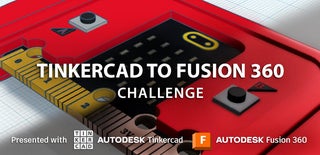Introduction: Build Your Own Retrograde Clock!
Hello fellow makers!
In this Instructable I would like to show you guys how to create your very own cool steampunk looking retrograde clock.
I LOVE weird intricate clocks and this one is definitely up there with my favourites, and it's easy to make too!
I started making the clock with Tinkercad but after making the clock face I had to switch to Fusion 360 to design the more intricate details of the gears and arms... and get some pretty awesome renderings in the process too!
Join me to learn how to make your very own...
Supplies
To replicate this Instructable you will need the following:
- Access to a 3D printer
This project uses very little filament with absolute no wastage.
- Clock movement
I used a 5168 movement that I had lying around but have included a link to a high torque 12888 movement that will be able to take more load. Just be sure to order the right thread length according to how thick your clock face is.
- 2mm Brass rod
This will be the shafts of the movement.
- 2mm Drill
This is to clean and size the holes in the print.
Optional:
- Polycarbonate sheet
It only needs to be 20cmX30cm
- Access to a CNC
This is only if you are making the clock face out of polycarbonate like mine.
*As an Amazon Associate I receive a small percentage from sales made through provided links at no cost to you, this helps fund future projects.
Step 1: The Retrograde Movement:
After recently seeing a post on Reddit about a retrograde clock I immediately fell in love with the mechanical movement of it and knew I just had to create my own.
The information available on the movement is very limited, here is a short explanation I found on hautehorlogerie.org about the retrograde movement.
“Retrograde” hands sweep a segment of a circle before springing back to their initial position to begin their movement again. Their endless choreography is an inspiration for innovative and highly spectacular dials.
While most watches display time by means of hands rotating on an axis, some watchmakers have given free rein to their creativity by developing alternative displays. In the late seventeenth century, some pocket watches' hour hand would sweep a segment of a circle for half the day then return to its starting point to begin all over again.
Abraham-Louis Breguet used this type of "retrograde" mechanism in the late eighteenth century for functions such as the date or the equation of time. After falling somewhat out of favour, retrograde displays returned to the spotlight on late twentieth-century wristwatches.
Today they are very much in vogue and take all manner of forms. Technically speaking, there is nothing revolutionary about this system as the movement's overall construction remains the same. The difference comes at the very end with the complex mechanism of rack, pawls and springs, conceived and made with the utmost precision, that drives the hands.
Retrograde hands lend themselves to all types of indication, for example the hour, minute and date, and this versatility has inspired a wave of "bi-retrograde" and "tri-retrograde" watches. The retrograde system is especially impressive with fast-moving indications such as the seconds. Very often, retrograde hands are combined with jumping indications.
Step 2: Design:
I designed the clock face in Tinkercad so that it can easily be exported as an SVG for my little home-brew CNC to cut out of some polycarbonate.
If you don't have access to a CNC in order to cut out the clock face you can also print it as is and also bend it as shown in a later step.
Because of the complexity of the movement itself I needed to move the project over to Fusion 360 to continue on the finer detail work. You can do this easily by selecting "Send To" in your Tinkercad workspace and then "Autodesk Fusion 360".
Step 3: Printing:
Now that the design is complete we can start printing the components.
In total the entire mechanism took less than 8 meters of filament and less than 2 hours to print making this a very economical AND FUN print.
I used SBS (not a spelling error) filament to print all the parts. This is still a fairly unknown filament but here in South Africa we have a local manufacturer, it is a inexpensive, ultra strong, lightweight filament that has the properties of ABS but the print-ability of PLA with some added rubberiness. If you haven't tried it yet I would highly recommend you do!
My print settings are as follows:
Material: Black SBS
Speed: 80mm/s (Prusaslicer default)
Temp: 220 degC Nozzle and 85 degC Bed
Nozzle: 0.4mm
With SBS I use no part cooling fan
Attachments
Step 4: Cutting the Clock Face:
Now we need to cut out the clock face using a CNC and some polycarbonate.
Like I said in the previous step you can also print this part if you do not have access to a CNC.
I chose to use a sheet of 5mm thick polycarbonate as this gave me a nice solid base with some weight and also makes the time indicators stand out more. But you can also use 3mm.
Polycarbonate is pretty easy to cut on a hobby level CNC using a normal 2 flute 3.175mm 1/8in endmill, the most important thing is to have your feed rate right to prevent the plastic from melting onto the endmill.
I like to spray some WD-40 onto the workpiece as this helps prevent sticking and gives nice clean cuts.
Step 5: Bending the Clock Face:
Now that the clock face is cut we need to form the stand.
Using a heat gun I started slowly heating up the slit in the face until it gets pliable, you want to be careful not to heat it up too quickly or hot otherwise it will create bubbles.
Bent the bottom piece about 80 degrees back, we want to transfer some of the weight to the back of the stand so that the clock won't tip forward but also not to much as you want the mechanism to "hang" freely.
Step 6: Prep Your Parts:
Before we can start assembly we need to clean up and bits and blobs that might be on the prints.
While this might seem like extra work remember that your clock movement has very little torque so the mechanism needs to run as smoothly as possible.
To start I used a 2mm drill to clean up the holes and make them spin freely on the 2mm brass rods.
Next I switched to a small file to just clean out the teeth on the gears and then I used a brass brush in my Dremel to clean up any burrs.
Step 7: The Brass Supports:
The brass rods you buy are usually slightly oxidised, this layer will create some friction on the parts and keep them from spinning smoothly.
I used some fine steel wool to first get rid of the oxidation and then followed up with some metal polish to get a mirror finish on the rods.
Next cut two pieces of rod to 18mm and round the edges slightly to make assembly easier.
Step 8: Assembly: Part 1
Time to start assembling your clock!
We start by pushing in the two rods into the printed clock support, this support will then be pushed through the corresponding holes in the clock face. Take note that the slightly shorter pillar needs to be in the centre.
Next we can screw the clock movement into place, depending on the model you have you might need to add a washer in the back for it to sit flush. Remember not to over tight these as they are somewhat fragile.
Step 9: Optional: PTFE Spacers
Because my filament has some ruberiness to it the parts tended to not slide freely against each other, so I had to figure out a way to increase the slip.
Luckily the solution was already laying right in front of me on my bench.
Bowden tubing used in 3D printers are made from super slippery PTFE and has a inside diameter of you guessed it.. 2mm! absolutely perfect.
I used a sharp hobby knife to cut slithers as thin as possible from the tube.
Step 10: Assembly: Part 2
Next we need to put on the hour and minute hands (with our new PTFE washers inbetween) onto the middle post followed by the two geared arms onto the opposite post.
Finally the fibonacci spirals go onto the clock movement, first the hour ( the bigger hole ) then the minute spiral.
Step 11: The Stack:
Step 12: Optional: Additional Weight
Sometimes the hands of the clock would not drop down fully after 12, this was caused by some friction.
To overcome this I needed to add some additional weight to the ends of the arms, I wanted to redo the design with some more material on the tips but in testing I just shoved a piece of the off cut brass rod into it and liked the look so much that I decided to just keep it that way.
Step 13: Updates:
I will be posting any updates and changes to the design here:
Step 14: Enjoy!
Your clock is now ready to use!.. Adjust the time, set it in its new spot and enjoy.
I hope you guys enjoyed this Instructable and if you have any questions please feel free to leave me a comment bellow.
Please share your own creations with us by clicking the "I Made It" button below.
Happy making!

First Prize in the
Tinkercad to Fusion 360 Challenge




















